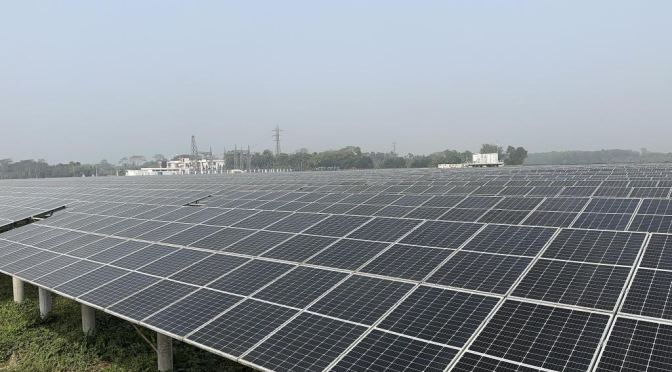Mymensingh district in north-central Bangladesh has a diverse landscape of valleys and mountainous terrain. With a height of 19 meters above the sea, the district is the highest place of all the main cities of the delta country.
Due to its elevation, the district enjoys more sunlight than anywhere else in the South Asian country. On a flat piece of land in the district there are about 169,000 solar panels arranged in rows that absorb the sun’s energy.
The 50 MW PV power plant built with investment from HDFC SinPower Ltd., whose majority shareholder is China Huadian Overseas Investment Co., Ltd. began construction in September 2019 to take advantage of solar resources here.
Overcoming difficulties during construction, the project was put into commercial operation in November 2020 and became the largest solar power plant in Bangladesh at that time.
“We never thought that electricity would be generated from sunlight, (and) now electricity is generated from sunlight,” Nasir Uddin, a local resident, told Xinhua recently. “Many of our sons, daughters and relatives are working in this power plant, which benefits us greatly.”
To date, the solar plant has been in continuous and safe production for about 1,200 days, and the cumulative power generation has reached about 300 million KWH. The clean energy generated by the plant is supplied to the national grid for the local population.
Local farmer Rafiqul Islam Rafiq said, “People of our area are proud of the installation of the solar power plant here.” Thanks to this plant, the residents of the area receive electricity and their standard of living has greatly improved, he said.
Expressing gratitude to China for the solar park under the Belt and Road Initiative, the farmer said people are benefiting from Chinese investments in Bangladesh.

Photo taken on February 17, 2024 shows a 50 MW photovoltaic power plant built by China in Mymensingh district, Bangladesh. Mymensingh district in north-central Bangladesh has more sunlight than anywhere else in the South Asian country. The 50 MW PV power plant built with investment from HDFC SinPower Ltd., whose majority shareholder is China Huadian Overseas Investment Co., Ltd., began construction in September 2019 to take advantage of solar resources here. (Xinhua)
By Sun Nan and Naim-Ul-Karim
“I want to express my gratitude and thanks from the bottom of my heart to all the Chinese who worked behind this,” he said.
The plant now serves as an epitome of growing green energy development in Bangladesh, as the country has announced it will reduce carbon dioxide emissions by 2030.
As stated by the plant’s engineer, Jamel Mahmoud Faisal, “This 50 MW PV plant was a benchmark in terms of technological standard or construction standard. Because its construction took very little time during the strict COVID-19 situation in Bangladesh”, and added that “it is the speed of China and it is the record.”
Being the first green energy project to use the Chinese standard, “I would say that this standard is very high, whether for the maintenance section or for safety reasons,” said the engineer.
The project reduces carbon emissions by more than 50,000 tonnes per year and also completed Verified Carbon Standard certification in January 2023, meaning it has international carbon trading rights.
Zhou Jinshun, president of HDFC SinPower Limited Company, said that based on the implementation of the concept of low-carbon development and the practice of sustainable green energy development, the project actively explores the growth of new values of green economy.
Looking to the future, Zhou said: “We are committed to making greater contributions to promoting local economic development, improving the livelihood and well-being of local people, and promoting exchanges between China and Bangladesh.”


